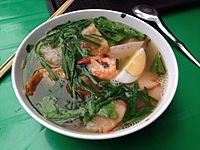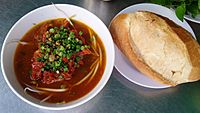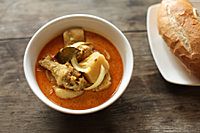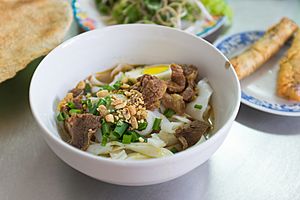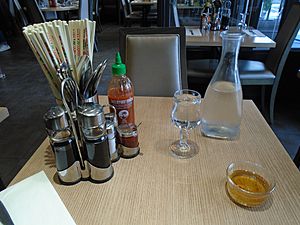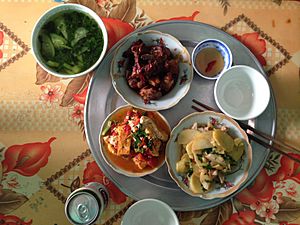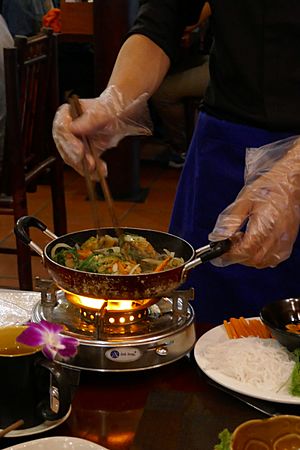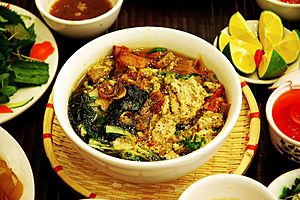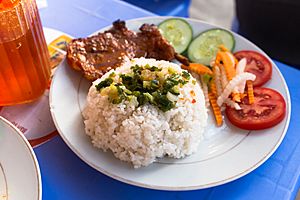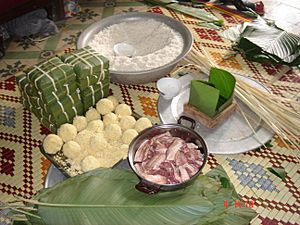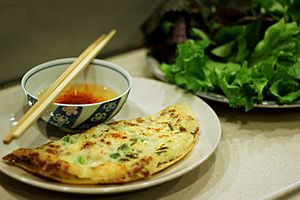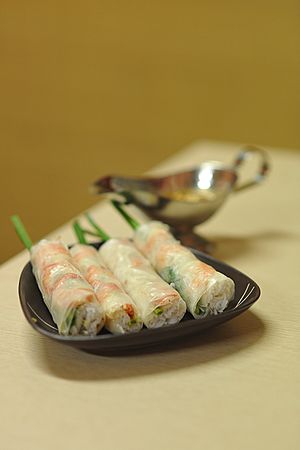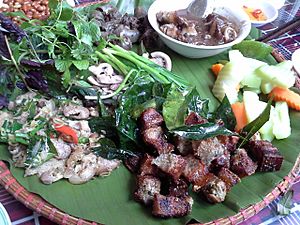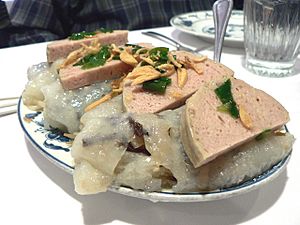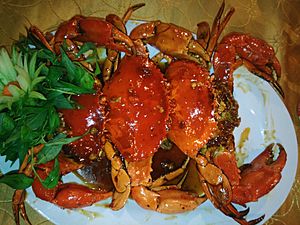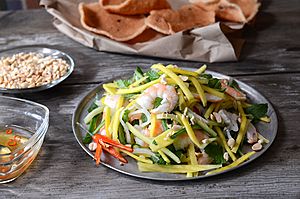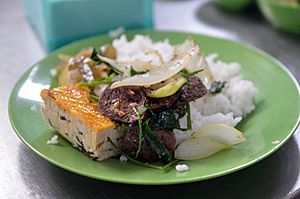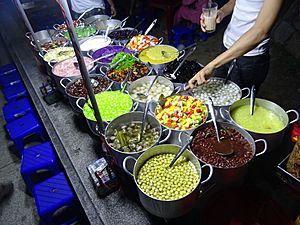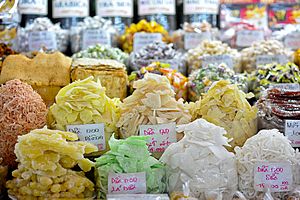Vietnamese cuisine facts for kids
Vietnamese cuisine is all about the delicious foods and drinks from Vietnam. Meals often mix five main tastes: sweet, salty, bitter, sour, and spicy. Each dish is special because it uses different ingredients and colors, following a "five-element" idea.
Vietnamese recipes use fresh ingredients like lemongrass, ginger, mint, and lime. Traditional cooking often uses fresh items, not much dairy or oil, and lots of herbs and vegetables. Many dishes are naturally gluten-free because they use rice noodles and rice flour instead of wheat. Vietnamese food has been influenced by nearby countries like China, Cambodia, and Laos, and also by French cuisine because of Vietnam's history with France.
Did you know that fish sauce (nước mắm) is super popular in Vietnamese homes? It's used much more than soy sauce!
Contents
How History Shaped Vietnamese Food
Vietnamese food has its own unique style, but it also has influences from other cultures. For hundreds of years, Vietnam had close ties with China. This led to some Vietnamese dishes being similar to Chinese ones.
The Chinese brought many foods to Vietnam. These include wonton (vằn thắn), char siu (xá xíu), har gow (há cảo), and shahe fen (hủ tiếu). They also introduced wheat noodles (mì), popiah (bò bía), and youtiao (bánh quẩy). Even mooncakes and baozi (bánh bao) came from China. Vietnamese cooks took these foods and added their own special flavors to them.
The French also brought new things to Vietnam. They introduced baguettes, which became the famous Vietnamese sandwich called bánh mì. This tasty fast food is filled with Vietnamese ingredients. The French also brought vegetables like onions, cauliflower, lettuce, and potatoes. They even introduced coffee! Many Vietnamese words for these new ingredients come from adding "tây" (meaning "western") to a similar Vietnamese word. For example, onions are "hành tây" (western shallots).
French influence also led to many dishes like salads (sa lát), pâté, and bánh flan (flan). They also introduced dairy products like butter and yogurt.
Vietnamese food also has influences from Champa, Malaysia, and Cambodia. For example, using coconut milk and dishes like bánh khọt came from Cham cuisine. Spices like curries were brought by Malay and Indian traders. Cà ri gà (chicken curry) is very popular in central and southern Vietnam. It's often eaten with bread, rice, or rice noodles.
Food from Different Regions
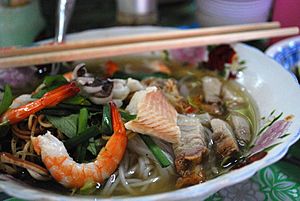
Even though Vietnam is one country, its food changes a lot from north to south. But some things are the same everywhere:
- Freshness: Most meats are cooked quickly. Vegetables are often eaten fresh or lightly cooked.
- Herbs and Vegetables: These are super important and used a lot in many dishes.
- Different Textures: You'll find crunchy with soft, or watery with crispy.
- Soups: Broths and soups are common in all regions.
- Pretty Presentation: Food is often arranged to look nice and colorful.
Northern Vietnam
In northern Vietnam, the weather is colder, so there are fewer spices. This means the food is usually less spicy. They use black pepper more than chili peppers. Northern Vietnamese food has light and balanced flavors. In the past, meats like pork, beef, and chicken were not used as much. Instead, people ate a lot of freshwater fish, prawns, squids, and crabs. Many famous northern dishes, like bún riêu (crab noodle soup) and bánh cuốn (steamed rice rolls), started here. Other famous dishes from Hanoi include bún chả (grilled pork with noodles) and phở gà (chicken noodle soup).
Central Vietnam
Central Vietnam has mountains that produce many spices. So, the food here is known for being spicy! This makes it different from the other regions. Huế, which was once the capital, has very fancy and colorful food. This shows the influence of ancient royal cooking. Meals here often have many small, complex dishes. Chili peppers and shrimp sauces are used a lot. Famous dishes from central Vietnam include bún bò Huế (spicy beef noodle soup) and bánh khoái (a type of savory pancake).
Southern Vietnam
The warm weather and rich soil in southern Vietnam are perfect for growing many fruits, vegetables, and raising animals. So, food here is often very flavorful and colorful. They use a lot of garlic, shallots, and fresh herbs. Sugar is added more often than in other regions, and coconut milk is used a lot. Because of the long coastline, seafood is a main food. Some famous seafood dishes are bánh khọt (mini savory pancakes) and bún mắm (fermented fish noodle soup).
The Mekong Delta region, a new area, uses lots of fresh ingredients like palm sugar, fermented fish, seafood, and wild herbs. Its food is also influenced by Khmer, Cham, and Chinese settlers.
Vietnamese Food and Balance
Vietnamese cooking often follows the idea of "five elements" (ngũ vị), which is about balance.
- Five Tastes: Many dishes have all five tastes: spicy (metal), sour (wood), bitter (fire), salty (water), and sweet (earth). These tastes are linked to different parts of the body.
- Five Nutrients: Cooks try to include five types of nutrients: powder, liquid, minerals, protein, and fat.
- Five Colors: Dishes often have five colors: white, green, yellow, red, and black.
- Five Senses: Vietnamese food appeals to all five senses: it looks good, crisp ingredients make sounds, spices are tasted, herbs smell wonderful, and some foods are fun to touch.
Yin-Yang Balance
The idea of yin and yang is also important. This means balancing "heating" and "cooling" properties of ingredients to be good for the body. For example:
- Duck meat is considered "cool" and is eaten in summer with "warm" ginger fish sauce.
- Chicken, which is "warm," and pork, which is "hot," are eaten in winter.
- Seafood, which is "cool" or "cold," goes well with "warm" ginger.
- Spicy foods ("hot") are balanced with sourness, which is "cool."
- Balut (a fertilized duck egg, considered "cold") is eaten with Vietnamese mint (rau răm), which is "hot."
Food and Daily Life
Vietnamese food shows how people live. Because many Vietnamese people have faced tough times, ingredients are often inexpensive. But they are cooked in creative ways to make simple-looking dishes taste amazing and have a good balance.
To save money, Vietnamese cooking uses every part of an ingredient. For example, every part of a cow is used, from the meat to the insides. Nothing is wasted! The same goes for vegetables like scallions; the leafy parts are used for flavor, and the roots can be replanted.
Fish sauce (nước mắm) is the most famous sauce in Vietnamese cooking. It's made from fermented fish and is served with almost every dish. A typical meal in southern Vietnam might include plain white rice, catfish stewed in a clay pot, and sour soup with snakehead fish. And of course, fish sauce!
Typical Vietnamese Family Meal
Daily meals for Vietnamese families are often different from what you see in restaurants. A typical family meal usually has:
- Cơm trắng: Cooked white rice.
- Món mặn: Main dishes like fish, meat, or tofu, cooked in different ways.
- Rau: Cooked or fresh green vegetables.
- Canh: A clear soup with vegetables, and sometimes meat or seafood.
- Nước chấm: Dipping sauces like fish sauce, soy sauce, or salt with lime and chili.
- Small side dishes like pickled eggplant or cabbage.
- Tráng miệng: Desserts like fresh fruits or sweets such as chè.
Except for individual rice bowls, all dishes are shared in the middle of the table. It's polite for younger people to wait for elders to start eating first. People also "invite" others to enjoy the meal and sometimes pick up food for each other to show care.
Feasts
A feast (cỗ) is a big event for families or villages, usually for up to 12 people per table. Feasts are held for weddings, funerals, and festivals. They don't serve everyday foods, but plain rice is still included.
A Vietnamese feast has two parts: the main course (salty dishes) and dessert (sweet dishes). All main course dishes are served at the same time. A big pot of soup or a hot pot is usually placed in the center of the table.
A basic feast in northern Vietnam might have 10 dishes: five in bowls (like fried fish belly, cellophane noodles, bamboo shoot, meatball, and chicken stew) and five on plates (like Vietnamese sausage, boiled chicken or duck, and Vietnamese salad).
Royal Cuisine
During the Nguyễn dynasty, the king had 50 of the best chefs serving him. He would have 12 dishes for breakfast and 66 dishes for lunch and dinner! Special dishes included bird's nest soup, shark fin, and abalone. Even the water for cooking came from specific wells or rivers. Clay pots were used only once and then thrown away. The king ate alone in a comfortable room with music.
Cultural Importance
Food is very important in Vietnamese culture. Salt is seen as a connection between the living and the dead. Bánh phu thê (a sweet cake) reminds new couples of perfection and harmony at weddings. Food is often placed on the family altar as an offering to ancestors during special times like Lunar New Year.
Proverbs About Food
The word ăn (to eat) is in many Vietnamese proverbs, showing how important eating is:
- Ăn trông nồi, ngồi trông hướng ("Check the rice pot when eating, watch where you are sitting.") = Be careful not to make mistakes.
- Cha ăn mặn, con khát nước ("The father eats salty food, the children go thirsty.") = Bad actions can affect future generations.
- Học ăn, học nói, học gói, học mở ("Learn how to eat, how to speak, how to wrap, how to open.") = Everything needs to be learned, even simple manners like eating politely.
Vietnamese Food Around the World
Vietnamese food is very popular outside of Vietnam, especially in countries where many Vietnamese people live, like Australia, the United States, Canada, and France. It's also liked in Japan, Korea, and parts of Europe.
Many TV shows feature Vietnamese food. For example, Luke Nguyen from Australia has a show called Luke Nguyen's Vietnam, which teaches how to cook Vietnamese dishes. Famous chef Gordon Ramsay visited Vietnam and loved the food, even calling a noodle dish "The greatest dish I have ever eaten!"
Cooking Techniques
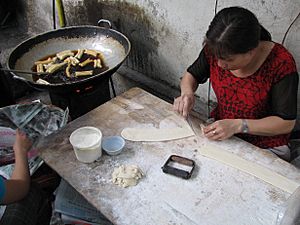

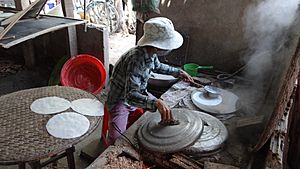
Here are some common Vietnamese cooking words:
- Rán, chiên – fried dishes.
- Xào – stir-fry.
- Kho – stew or braised dishes.
- Luộc – boiling, usually for vegetables and meat.
- Hấp – steamed dishes.
- Nướng – grilled dishes.
- Cháo – congee (rice porridge).
- Súp – soup.
- Lẩu – hot pot dishes.
- Cuốn – dishes wrapped in rice paper with noodles and herbs.
Vietnamese Kitchen Tools
Vietnamese kitchens use many tools, including:
- Bowls (small: bát or chén; large: tô)
- Chopsticks (đũa)
- Clay pot cooking (thố đất)
- Knife (dao)
- Mortar and pestle (cối giã and chày)
- Plate (dĩa or đĩa)
- Pots (nồi and niêu)
- Spoon (thìa or muỗng)
- Teacup (tách or chén uống trà)
- Teapot (ấm pha trà)
- Trays (mâm and khay)
Common Ingredients
Vegetables
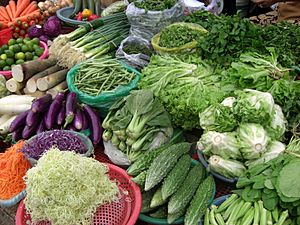
Common vegetables include:
- Bitter melon (khổ qua)
- Cabbage (bắp cải)
- Carrot (cà rốt)
- Cauliflower (bông cải)
- Chili pepper (ớt)
- Cucumber (dưa chuột)
- Eggplant (cà tím)
- Jicama (củ đậu)
- Water spinach (rau muống)
Fruits
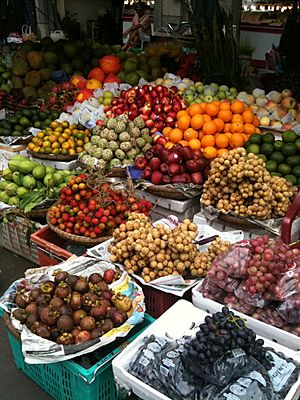
Vietnam has many delicious fruits:
* Papaya (đu đủ)
- Dragon fruit (thanh long)
- Rambutan (chôm chôm)
- Star fruit (khế)
- Watermelon (dưa hấu)
Herbs (rau thơm)
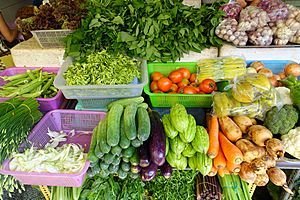
Herbs are key to Vietnamese flavors:
- Coriander leaf (rau mùi)
- Lemongrass (xả or sả)
- Dill (thì là)
- Long coriander (ngò gai)
- Mint (bạc hà)
- Perilla (tía tô)
- Thai basil (húng quế)
- Hot mint (rau răm)
Condiments and Sauces
Condiments
Vietnamese meals often come with fresh raw vegetables and herbs called rau sống. These are used to add flavor and crunch to many dishes. They include lettuce, bean sprouts, and various herbs.
Herbs and Spices
- Coriander and green onions are in most dishes.
- In northern Vietnam, fish dishes might have dill.
- In central Vietnam, ground lemongrass and chili are used with beef.
- In southern Vietnam, coconut water is used in stews.
- Culantro and rice paddy herb are a must in sour soups in southern Vietnam.
- Spearmint is often used with strong-smelling fish dishes.
- Perilla is usually paired with crab dishes.
Pairing
- Chicken dishes go well with lime leaves.
- Crab and seashell dishes are often eaten with fishy-smelling herb and perilla.
- "Cold" or "fishy" dishes like catfish are paired with ginger or lemongrass.
- Beef dishes are combined with celery or pineapples.
Sauces
- Nước chấm: A dipping sauce made from fish sauce mixed with lemon juice, garlic, sugar, and chili.
- Mắm tôm: Fermented shrimp paste.
- Tương: Made from fermented soybeans.
- Soy sauce: Used in marinades and sauces.
- Hoisin sauce: Used in Southern Vietnam with phở.
- Hot chili sauce.
Food Colorings
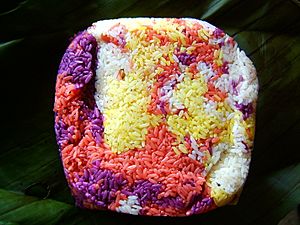
Traditional Vietnamese food gets its colors from natural ingredients:
- Red: From beetroot or annatto seeds.
- Orange: From gac fruit for sticky rice.
- Yellow: From turmeric.
- Green: From pandan leaf.
- Purple: From magenta plant leaves.
- Black: From ramie leaf for banh gai.
- Dark brown: From heating sugar until it caramelizes.
Popular Dishes
When you hear about Vietnamese dishes in English, they usually keep their Vietnamese names.
Noodle Soups
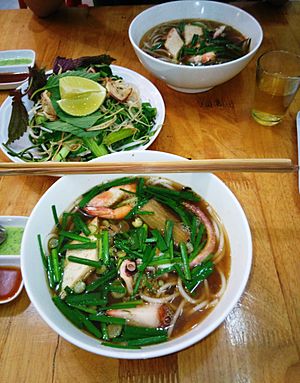
Vietnamese cuisine has many different noodle soups, each with its own special flavors and history. Most have a rich broth.
- Bún bò Huế: A spicy beef noodle soup from Huế. It gets its unique taste from beef bones, shrimp paste, lemongrass, and chili.
- Bún ốc: Vermicelli noodles with snails, tomato pork bone broth, tofu, and herbs.
- Bánh canh: A thick tapioca or rice noodle soup, often with pork, crab, or chicken.
- Bún riêu: A noodle soup with thin rice noodles, crab, shrimp paste, and a tomato broth.
- Phở: The most famous Vietnamese noodle soup! It has a rich, clear broth made from long-boiled meat and spices. It's usually made with beef or chicken and served with fresh herbs.
Soups and Cháo (Congees)
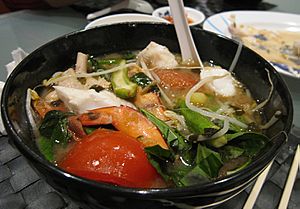
- Lẩu (Vietnamese hot pot): A spicy version of Vietnamese sour soup with vegetables, meats, and seafood.
- Cháo: A type of congee (rice porridge) made with different broths and meats like duck or chicken (cháo gà).
- Bò kho: Beef stew with carrots, often served with toasted bread or rice noodles.
- Canh chua: Vietnamese sour soup, usually with fish, pineapples, tomatoes, and herbs.
Rice Dishes
- Cơm chiên Dương Châu: A Chinese-style fried rice dish, very popular in Vietnam.
- Cơm hến: Rice with clams, a popular and cheap dish from Huế.
- Cơm tấm: Broken rice served with grilled pork, shredded pork skin, and a sweet and sour fish sauce.
Sticky Rice Dishes
- Bánh chưng: Sticky rice wrapped in banana leaves and filled with mung bean paste, pork, and black pepper. It's traditionally eaten during Lunar New Year.
- Xôi: Sticky rice cooked with coconut milk, often steamed for a firmer texture.
Bánh (Pastries/Cakes)
Bánh is the Vietnamese word for many kinds of pastries or cakes. Many are wrapped in leaves and boiled or steamed.
- Bánh bao: A steamed bun dumpling often filled with onion, mushrooms, or meat. It's a Vietnamese version of the Chinese baozi.
- Bánh bèo: A central Vietnamese dish of tiny, round, rice flour pancakes topped with minced shrimp and other ingredients.
- Bánh xèo: A crispy, pan-fried pancake made of rice flour, turmeric, shrimp, pork, and onions. It's eaten with lettuce and herbs, dipped in fish sauce.
Wraps and Rolls
- Bánh cuốn: Rice flour rolls filled with ground pork, prawns, and wood ear mushrooms.
- Chả giò or nem rán: Deep-fried spring rolls filled with pork, yam, crab, shrimp, and mushrooms.
- Gỏi cuốn: Also known as Vietnamese fresh rolls or summer rolls. These are rice-paper rolls filled with shrimp, herbs, pork, and rice vermicelli, dipped in fish sauce or peanut sauce.
Sandwiches and Pastries
- Bánh mì kẹp thịt: Vietnamese baguette filled with pâté, mayonnaise, cold cuts, jalapeños, pickled vegetables, and cucumber. It's often garnished with coriander and black pepper.
- Bánh Pâté chaud: A French-inspired meat-filled pastry with a flaky crust.
Meat Dishes
- Bò kho: A beef and vegetable stew, often served hot with French baguettes.
- Bò lúc lắc: Cubed beef sautéed with cucumber, tomatoes, and onions, served with rice.
- Chả lụa: A sausage made with ground lean pork and potato starch. Other types are made with chicken, beef, or fish.
- Nem nướng: Grilled meatballs, usually made of seasoned pork, often on skewers.
Seafood Dishes
- Bánh Tôm: Prawn and sweet potato fritter.
- Cá kho tộ: Caramelized fish in a clay pot.
- Chạo tôm: Prawn paste on sugarcane.
- Cua rang muối/me: Wok-tossed crab with salt and pepper or tamarind.
Salads
Nộm (Northern) or Gỏi (Southern) means Vietnamese salad.
- Gỏi đu đủ: Vietnamese papaya salad with shredded papaya, herbs, and meats like shrimp or pork.
- Nộm ngó sen: Lotus stem salad with shrimp and pork or chicken.
- Gỏi gà bắp cải: Chicken and cabbage salad.
Curries
Vietnamese curry is popular, especially in central and southern Vietnam, due to influences from Indian, Khmer, and Malay traders.
- Beef brisket curry or oxtail curry is often served with French bread or rice.
- Cà ri gà: A popular chicken curry with carrots, sweet potatoes, and peas in a coconut curry sauce.
Preserved Dishes
Muối (salting) and chua (sour/fermenting) are ways to preserve food in Vietnam. Because of the tropical climate, there are many vegetables year-round. Preserved dishes are mostly pickled vegetables. Seafood is often made into a fermented form called mắm.
- Dưa chua: Pickled mustard greens.
- Cà pháo muối: Pickled Vietnamese eggplant.
- Dấm tỏi: Pickled garlic cloves in vinegar.
Mắm
Mắm is a Vietnamese term for fermented fish, shrimp, or other seafood. It can be a main dish, an ingredient, or a condiment. The fish flesh stays whole, unlike in nước mắm (fish sauce), which is the liquid from the fermentation process.
- Mắm tôm: Fermented shrimp paste.
- Nước mắm: The general name for all fish sauces, usually referring to pure anchovy fish sauce.
Fermented Meat Dishes

Nem chua is a Vietnamese fermented meat, often pork, mixed with pork skin and wrapped in leaves. It takes about three to five days to ferment and can be eaten as is or fried.
Sausages
Vietnamese sausage, giò, is usually made from fresh ground pork and beef. Fish sauce is added, and the mixture is wrapped in banana leaves and boiled.
Vegetarian Dishes
Vegetarian dishes in Vietnam often have the same names as meat dishes, but with "chay" (vegetarian) added. For example, phở chay is vegetarian phở with tofu instead of meat. Many soups, sandwiches, and street foods have vegetarian versions. Vegetarian food is usually cheaper and is often eaten by religious people or during special holidays like Lunar New Year for good luck.
Desserts
- Chè: A sweet dessert drink or pudding, often made from beans and sticky rice. There are many kinds, with different fruits and beans, served hot or cold, often with coconut milk.
- Rau câu: A popular dessert made from red algae, flavored with coconut milk or pandan. It's eaten cold.
- Chuối chiên: Deep-fried banana, often served hot with cold ice cream.
- Bánh flan: A dessert influenced by French cuisine, served with caramel or coffee sauce.
- Sinh tố: A fruit smoothie made with sweetened condensed milk, crushed ice, and fresh fruits like avocado, jackfruit, or mango.
- Sữa chua: A local type of yogurt, brought by the French. It's sweet and tart and can be eaten cool or frozen.
- Bánh bò: A sweet and airy sponge cake flavored with coconut milk.
Mứt
Mứt are candied fruits or fruit preserves. They often have a mix of sour, sweet, salty, and spicy tastes. A famous kind is ô mai mơ, made from apricots with ginger, sugar, and liquorice.
Tofu
Tofu (đậu phụ) is used a lot in Vietnamese cooking. It can be boiled, fried, or used in many different dishes. Other soybean products include soy sauce, fermented bean paste (tương), and sweet tofu soup (tàu hũ nước đường).
Beverages
- Jasmine tea: A popular local tea.
- Bia hơi: A special local draft beer.
- Cà phê sữa đá: Strong dark roast iced coffee with sweetened condensed milk, very popular.
- Cà phê trứng: Coffee made with egg yolk, whipping cream, condensed milk, and espresso.
- Nước mía: Sugarcane juice, often with kumquat, served with ice.
- Rau má: Pennywort juice, a green drink served over ice.
- Sữa đậu nành: A soybean drink, hot or cold, often with pandan leaves.
- Rượu đế: A strong liquor made from rice.
- Trà đá: Iced tea, popular and cheap.
- Sinh tố: Vietnamese fruit smoothie.
See also
 In Spanish: Gastronomía de Vietnam para niños
In Spanish: Gastronomía de Vietnam para niños


